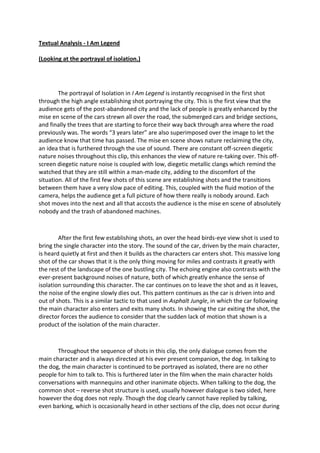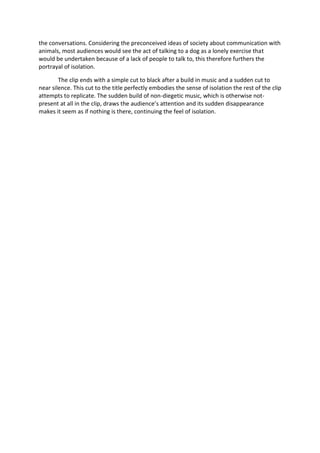A Textual Analysis Of I Am Legend
- 1. Textual Analysis - I Am Legend <br />(Looking at the portrayal of isolation.)<br />The portrayal of Isolation in I Am Legend is instantly recognised in the first shot through the high angle establishing shot portraying the city. This is the first view that the audience gets of the post-abandoned city and the lack of people is greatly enhanced by the mise en scene of the cars strewn all over the road, the submerged cars and bridge sections, and finally the trees that are starting to force their way back through area where the road previously was. The words “3 years later” are also superimposed over the image to let the audience know that time has passed. The mise en scene shows nature reclaiming the city, an idea that is furthered through the use of sound. There are constant off-screen diegetic nature noises throughout this clip, this enhances the view of nature re-taking over. This off-screen diegetic nature noise is coupled with low, diegetic metallic clangs which remind the watched that they are still within a man-made city, adding to the discomfort of the situation. All of the first few shots of this scene are establishing shots and the transitions between them have a very slow pace of editing. This, coupled with the fluid motion of the camera, helps the audience get a full picture of how there really is nobody around. Each shot moves into the next and all that accosts the audience is the mise en scene of absolutely nobody and the trash of abandoned machines.<br />After the first few establishing shots, an over the head birds-eye view shot is used to bring the single character into the story. The sound of the car, driven by the main character, is heard quietly at first and then it builds as the characters car enters shot. This massive long shot of the car shows that it is the only thing moving for miles and contrasts it greatly with the rest of the landscape of the one bustling city. The echoing engine also contrasts with the ever-present background noises of nature, both of which greatly enhance the sense of isolation surrounding this character. The car continues on to leave the shot and as it leaves, the noise of the engine slowly dies out. This pattern continues as the car is driven into and out of shots. This is a similar tactic to that used in Asphalt Jungle, in which the car following the main character also enters and exits many shots. In showing the car exiting the shot, the director forces the audience to consider that the sudden lack of motion that shown is a product of the isolation of the main character.<br />Throughout the sequence of shots in this clip, the only dialogue comes from the main character and is always directed at his ever present companion, the dog. In talking to the dog, the main character is continued to be portrayed as isolated, there are no other people for him to talk to. This is furthered later in the film when the main character holds conversations with mannequins and other inanimate objects. When talking to the dog, the common shot – reverse shot structure is used, usually however dialogue is two sided, here however the dog does not reply. Though the dog clearly cannot have replied by talking, even barking, which is occasionally heard in other sections of the clip, does not occur during the conversations. Considering the preconceived ideas of society about communication with animals, most audiences would see the act of talking to a dog as a lonely exercise that would be undertaken because of a lack of people to talk to, this therefore furthers the portrayal of isolation.<br />The clip ends with a simple cut to black after a build in music and a sudden cut to near silence. This cut to the title perfectly embodies the sense of isolation the rest of the clip attempts to replicate. The sudden build of non-diegetic music, which is otherwise not-present at all in the clip, draws the audience’s attention and its sudden disappearance makes it seem as if nothing is there, continuing the feel of isolation.<br />

